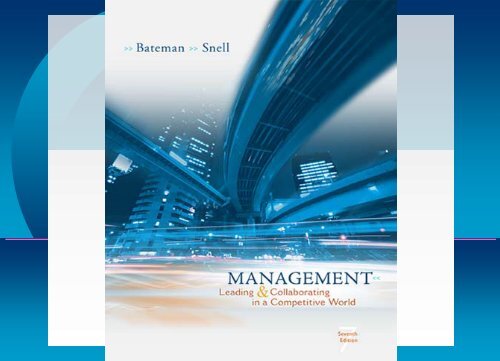Chapter 7
Chapter 7
Chapter 7
Create successful ePaper yourself
Turn your PDF publications into a flip-book with our unique Google optimized e-Paper software.
7-1
<strong>Chapter</strong><br />
7<br />
Entrepreneurship<br />
McGraw-Hill/Irwin<br />
Management, 7/e<br />
Copyright © 2007 The McGraw-Hill Companies, Inc. All rights reserved.
7-3<br />
Learning Objectives<br />
After studying <strong>Chapter</strong> 7, You will know:<br />
Why people become entrepreneurs, and what it<br />
takes, personally.<br />
How to assess opportunities to start new<br />
companies.<br />
Common causes of success and failure.<br />
Common management challenges.<br />
How to increase your chances of success,<br />
including good business planning.<br />
How to foster intrapreneurship and an<br />
entrepreneurial orientation in large companies.
7-4<br />
Entrepreneurship<br />
Entrepreneurship occurs when an<br />
enterprising individual pursues a lucrative<br />
opportunity<br />
Entrepreneurs initiate and build organizations<br />
Entrepreneurship involves creating new<br />
systems, resources, or processes to produce<br />
new goods or services and/or serve new<br />
markets
7-5<br />
Entrepreneurship vs. Small Business<br />
Small Businesses have fewer than 100<br />
employees, are independently owned and<br />
operated, thy are not dominant in their field<br />
and are not characterized by many innovative<br />
practices<br />
Entrepreneurial ventures are new businesses<br />
that have growth and high profitability as<br />
their primary objectives
Myths about Entrepreneurship<br />
7-6
7-7<br />
Why Become an Entrepreneur<br />
Entrepreneurs start their own firms because<br />
of:<br />
The challenge<br />
The profit potential<br />
Roadblocks at big corporations<br />
Frustration by bureaucracy or other features<br />
of corporate life<br />
The enormous satisfaction they hope lies<br />
ahead
Why Become an Entrepreneur<br />
7-8
7-9<br />
What does it take to Succeed?<br />
Innovation and creativity<br />
They possess knowledge and skills in<br />
Management<br />
Business<br />
Networking
7-10<br />
What Business Should You Start?<br />
Entrepreneurs generally look for two things when<br />
starting a business<br />
The idea itself<br />
An Opportunity<br />
Other Opportunities include<br />
Franchises<br />
Financial services<br />
Heal services and health-related things<br />
Travel<br />
Education
7-11<br />
The Next Frontier<br />
Space – Burt Rutan has<br />
started the first private<br />
business to launch<br />
people into space<br />
The Internet is a<br />
seemingly limitless<br />
frontier<br />
Side streets – these are<br />
unexpected opportunities<br />
that appear as you begin<br />
down a road and learn<br />
from trial and error
7-12<br />
What Does it Take, Personally?<br />
There is no single personality type that will<br />
predict entrepreneurial success<br />
Common characteristics include:<br />
Commitment and determination<br />
Leadership skills<br />
Opportunity obsession<br />
Tolerance of risk, ambiguity, and uncertainty<br />
Creativity, self-reliance, and ability to adapt<br />
Motivation to excel
7-13<br />
Success and Failure<br />
Start up companies have at least two major<br />
liabilities<br />
Newness<br />
Smallness<br />
Factors that influence success and failure are:<br />
Risk<br />
Economic environment<br />
Management related hazards<br />
Initial public stock offerings
7-14<br />
Increasing Your Chances of Success<br />
Start by conducting an opportunity analysis<br />
A description of the product or service, an<br />
assessment of the opportunity and the<br />
entrepreneur<br />
Create a business plan<br />
This is a formal planning step that focuses on<br />
the entire venture and describes all the<br />
elements involved in starting it
Opportunity Analysis<br />
7-15
Business Plan<br />
7-16
7-17<br />
Increasing Your Chances of Success<br />
Crucial to the success of the organization are<br />
many non-financial resources<br />
Legitimacy – People’s judgments of a<br />
company’s acceptance, appropriateness, and<br />
desirability, generally stemming, from<br />
company goals and methods that are<br />
consistent with societal values<br />
Networks<br />
Management teams<br />
Advisory Boards<br />
Partners
7-18<br />
Intrapreneurship<br />
Large corporations are more than passive<br />
bystanders in the entrepreneurial explosion<br />
Established companies try to find and pursue<br />
new and profitable ideas – to do so they need<br />
entrepreneurs
Intrapreneurship<br />
7-19
7-20<br />
Building Support for Your Idea<br />
Start by clearing the investment with your<br />
boss – formally get approval to pursue the<br />
idea<br />
Recruit cheerleaders – people who will<br />
support the idea prior to formal approval<br />
Be prepared to horse trade – promise payoffs<br />
in return for support, time, money and other<br />
resources<br />
Expect to get the blessing – this usually<br />
involves a formal presentation
7-21<br />
Building Intrapreneurship<br />
Two common approaches used to stimulate<br />
intrapreneurial activity are<br />
Skunk works – a project team designated to<br />
produce a new, innovative product<br />
Bootlegging – Informal work on projects, other<br />
than those officially assigned, of employees’<br />
own choosing and initiative
7-22<br />
Management Challenges<br />
Organizations that encourage<br />
intrapreneurship face risks<br />
The effort can fail<br />
Over reliance on a single project<br />
Efforts are spread over too many projects<br />
The hazards are also related to scale<br />
One large project is a threat<br />
Too many under funded projects are a threat<br />
as well
7-23<br />
Entrepreneurial Orientation<br />
This is the tendency of an organization to<br />
identify and capitalize successfully on<br />
opportunities to launch new ventures by<br />
entering new or established markets with new<br />
or existing goods or services<br />
Determined by five tendencies<br />
Allowing independent action<br />
Innovation<br />
Taking risks<br />
Being proactive<br />
Being competitively aggressive
7-24<br />
Looking Ahead<br />
<strong>Chapter</strong> 8 Organizational Structure<br />
How differentiation and integration influence an<br />
organization’s structure.<br />
How authority operates.<br />
The roles of the board of directors and the chief executive<br />
officer.<br />
How span of control affects structure and managerial<br />
effectiveness.<br />
Why effective delegation is important.<br />
The difference between centralized and decentralized<br />
organizations.<br />
The different ways organizations can be structured.<br />
The unique challenges of the matrix organization.<br />
The nature of important integrative mechanisms.
7-25<br />
The Idea<br />
Many great organizations<br />
have been built based on<br />
the founder’s desire to<br />
build a great organization<br />
rather than to offer a<br />
particular product<br />
Return<br />
After a job in corporate design turned out to be unsatisfying, Jennifer Velande<br />
found a creative outlet for herself—designing handbags. Soon, with the help<br />
of her friend Robin Newberry, Jennifer turned this “hobby” into a unique<br />
business concept. 1154 Lill now gives customers the opportunity to design<br />
their own original handbags.
7-26<br />
The Opportunity<br />
Entrepreneurs spot, create, and exploit<br />
opportunities in a variety of ways<br />
To spot opportunities, entrepreneurs think<br />
carefully about events and trends as they unfold<br />
Technological discoveries<br />
Demographic changes<br />
Lifestyle and taste changes<br />
Economic dislocations<br />
Calamities<br />
Government initiatives and rule changes<br />
Return
7-27<br />
Risk<br />
A fundamental problem<br />
with most entrepreneurs is<br />
they are unrealistic about<br />
the market demands or<br />
unrealistic about the costs<br />
of meeting those demands<br />
Mel Gibson (pictured right)<br />
risked $25 million of his<br />
own money to film The<br />
Passion of the Christ, an<br />
idea he believed in.<br />
Return
7-28<br />
Economic Environment<br />
Money is a critical resource<br />
for all new businesses<br />
Entrepreneurs must have the<br />
foresight and talent to<br />
survive when the<br />
environment becomes more<br />
hostile<br />
Business incubators are one<br />
way to prepare for the<br />
unexpected; these are<br />
protected environments for<br />
new, small business; they<br />
offer benefits such as low<br />
Return rents and shared costs
7-29<br />
Initial Public Stock Offerings<br />
IPO’s offer a way to raise<br />
capital through the sales of<br />
federally registered and<br />
underwritten shares of the<br />
company<br />
Advantages include raising<br />
more capital, reducing debt<br />
and enhancing net worth<br />
Disadvantages include the<br />
expense, time, and effort<br />
involved; along with the<br />
tendency to become more<br />
interested in the stock price<br />
and capital gains<br />
Return
7-30<br />
Management-Related Hazards<br />
You might not enjoy it<br />
Survival is difficult<br />
Growth creates<br />
challenges<br />
It’s hard to delegate<br />
Misuse of funds<br />
Poor controls<br />
Death<br />
Return
















